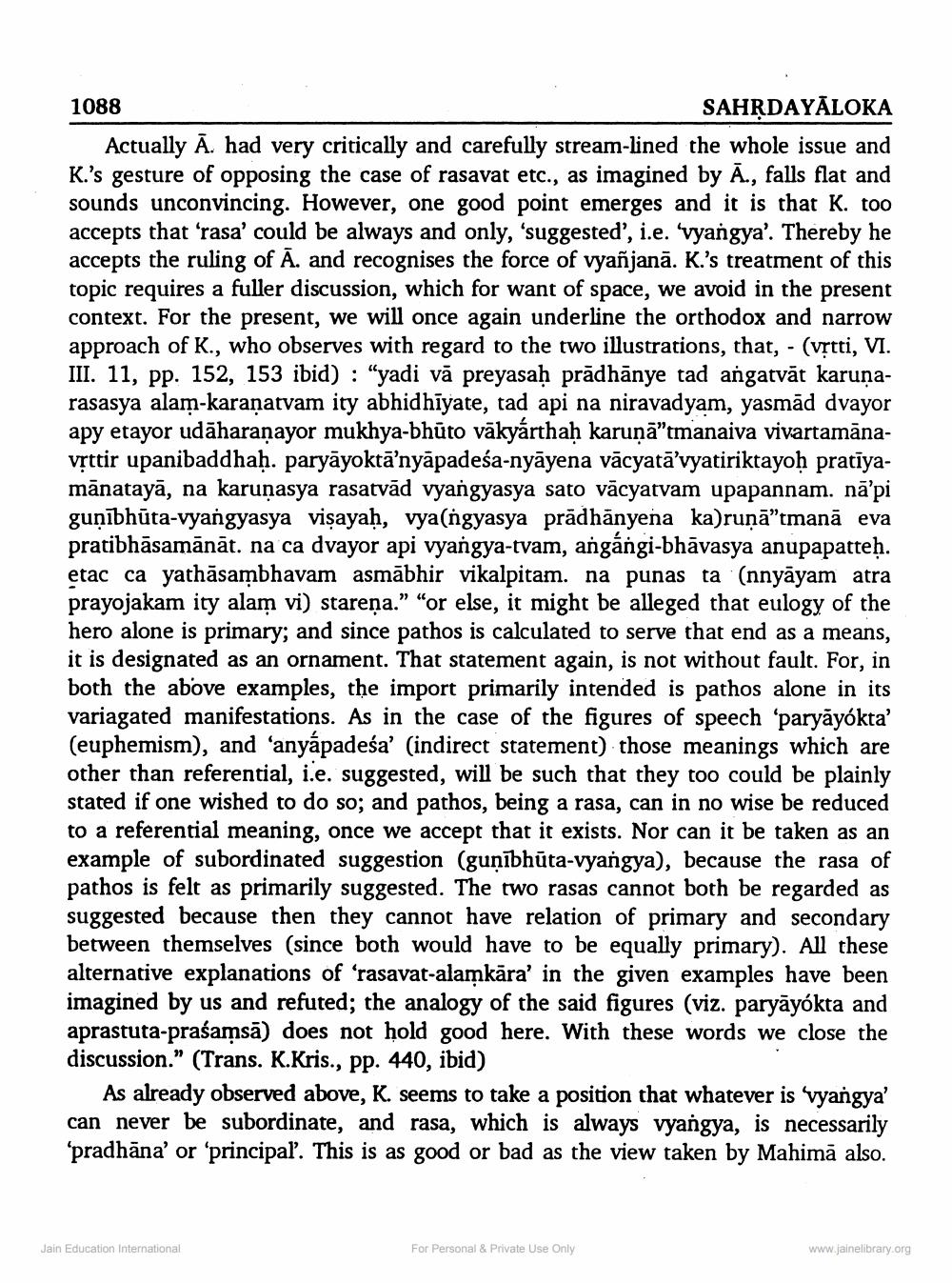________________
1088
SAHRDAYĀLOKA Actually Ā. had very critically and carefully stream-lined the whole issue and K.'s gesture of opposing the case of rasavat etc., as imagined by A., falls flat and sounds unconvincing. However, one good point emerges and it is that K. too accepts that 'rasa' could be always and only, 'suggested', i.e. 'vyangya'. Thereby he accepts the ruling of Ā. and recognises the force of vyañjanā. K.'s treatment of this topic requires a fuller discussion, which for want of space, we avoid in the present context. For the present, we will once again underline the orthodox and narrow approach of K., who observes with regard to the two illustrations, that, - (vrtti, VI. III. 11, pp. 152, 153 ibid) : "yadi vā preyasaḥ prādhānye tad angatvāt karunaasasya alam-karanatvam ity abhidhiyate, tad api na niravadyam, yasmad dvayor apy etayor udāharaṇayor mukhya-bhūto vākyárthaḥ karunā"tmanaiva vivartamānavịttir upanibaddhaḥ. paryāyoktā’nyāpadeśa-nyāyena vācyatā’vyatiriktayoh pratīyamānatayā, na karunasya rasatvād vyangyasya sato vācyatvam upapannam. nā’pi gunībhūta-vyangyasya visayaḥ, vya(ngyasya prādhānyena ka)ruņā”tmanā eva pratibhāsamānāt. na ca dvayor api vyangya-tvam, angángi-bhāvasya anupapatteh. etac ca yathāsambhavam asmābhir vikalpitam. na punas ta (nnyāyam atra prayojakam ity alam vi) stareņa.” “or else, it might be alleged that eulogy of the hero alone is primary; and since pathos is calculated to serve that end as a means, it is designated as an ornament. That statement again, is not without fault. For, in both the above examples, the import primarily intended is pathos alone in its variagated manifestations. As in the case of the figures of speech ‘paryāyókta’ (euphemism), and 'anyápadeśa' (indirect statement) those meanings which are other than referential, i.e. suggested, will be such that they too could be plainly stated if one wished to do so; and pathos, being a rasa, can in no wise be reduced to a referential meaning, once we accept that it exists. Nor can it be taken as an example of subordinated suggestion (gunībhūta-vyangya), because the rasa of pathos is felt as primarily suggested. The two rasas cannot both be regarded as suggested because then they cannot have relation of primary and secondary between themselves (since both would have to be equally primary). All these alternative explanations of 'rasavat-alamkāra' in the given examples have been imagined by us and refuted; the analogy of the said figures (viz. paryāyókta and aprastuta-praśamsā) does not hold good here. With these words we close the discussion.” (Trans. K.Kris., pp. 440, ibid)
As already observed above, K. seems to take a position that whatever is vyangya' can never be subordinate, and rasa, which is always vyangya, is necessarily ‘pradhāna' or 'principal. This is as good or bad as the view taken by Mahimā also.
Jain Education International
For Personal & Private Use Only
www.jainelibrary.org




